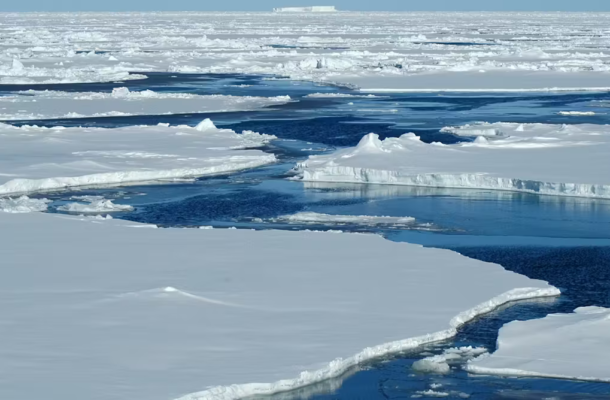The end of the ice

In 1897, the former whaling ship RV Belgica left Antwerp in Belgium and set sail due south. It was the first voyage of what would become known as the Heroic Age of Antarctic exploration. It did not go to plan.
After a six-month voyage, they begin encountering sea ice. Several times the ship is caught in the ice for a day or two. A crew member falls overboard and is lost to the icy waters. But the crew presses on, making measurements as they go. Expedition leader Adrien de Gerlache records the process:
“At noon we made a deep sea sounding, with a long series of temperatures at various depths. We lowered five hundred and sixty metres of wire, and brought up a cup of blue clay. The temperature at the surface was at the freezing point, and at the bottom slightly warmer.”
Their discovery of deep warmer water was important. It’s since been named Circumpolar Deep Water. In our time, this water is getting warmer and warmer, as oceans absorb nearly all the extra heat trapped by burning fossil fuels. Antartica’s seemingly impregnable ice is now melting from beneath.
But in 1898, the ice is strong. On March 4, the crew find themselves unable to move. As the southern winter looms, the ice thickens on the surface of the Bellingshausen Sea, to the west of the Antarctic Peninsula. The RV Belgica is trapped.

A winter of permanent night
The crew were about to become the first people to spend a winter south of the Antarctic Circle, enduring months of constant night. The expedition was largely unprepared for the bitter cold and darkness. But the first mate, a 25-year-old Norwegian named Roald Amundsen, felt differently. He had joined the expedition in search of adventure. He was not disappointed. “We must no doubt spend the winter here, and that is fine with me,” he wrote in his journal. Five days in, he writes:
“One starts to get familiar with the idea of wintering. The cold has begun sharply. The ice is firm around us and without ridges. This is starting to get interesting.”
As time drags on, the crew suffer from scurvy. The expedition leader and his second in command both become so ill they write their wills and retire to bed. Amundsen and the American surgeon Frederick Cook take over leadership.
Of this time, Cook writes in his journal:
“we jog along day after day, through the unbroken sameness […] the darkness grows daily a little deeper, and the night soaks hourly a little more colour from our blood.”
When pale sunlight returns in spring, it’s not enough to free the ship. By January 1899, the crew become desperate. Facing a second winter on the ice, they cut a channel through the sea ice and use explosives to widen it. After a month’s brutal labour, they free the ship and sail for home.

A little over a decade later, an expedition led by Amundsen would be the first to reach the South Pole.
And the RV Belgica? The ship spent its later years transporting coal, as demand for fossil fuels grew and grew.
The scientists and explorers aboard the Belgica did not waste their time. They meticulously recorded their location, the thickness of the sea ice and the weather.
In our time, the data gathered by the scientists and crew of the Belgica is proving invaluable.
Working with the team from the Australian Earth System Simulator, we used data from the Belgica’s crew and satellite imagery to recreate the ship’s path and compare it to what’s happening now.
If the RV Belgica had been in the same location in the Bellingshausen Sea off the Antarctic Peninsula in 2023, rather than 1897, the story would have been very different.
In the intervening 126 years, we set about changing the Earth’s climate in earnest. Fossil fuels gave us vastly more energy. But they came with a sting in the tail – burning them released long-buried carbon dioxide and other gases into the atmosphere, where they magnify the natural greenhouse effect which keeps the Earth from icing over. Almost all of the heat trapped by our activities has gone into the oceans.
In the north, the Arctic sea ice began to disappear from the 1970s onwards, shrinking by about 12% per decade.
Antarctica’s sea ice has held out for longer. A ship like the Belgica could have been stuck in sea ice as late as 2015.
No longer. The heat is on. In the last eight years, Antarctic sea ice has begun to melt in earnest. In the last three years, the melt has accelerated. Now, new research suggests Antarctic sea ice has undergone an “abrupt transition”.
In March 2023, the RV Belgica would have sailed through open waters where pack ice once groaned and cracked. There was almost no sea ice in the Bellinghausen Sea from February to April.
At the beginning of 2024, Australia’s marine research vessel, RV Investigator travelled 12,000km from Hobart down to the Antarctic coastline and back to Fremantle. What was shocking was how easy it was.
When sea ice is at its thickest, even modern vessels can struggle to navigate it. But on this voyage, scientists aboard collected vast amounts of data from dark oceans that should have been covered by thick sea ice.

The years of melting
In the ice continent, climate change is beginning to cause long-feared changes.
The Antarctic Peninsula – the long, trailing tail closest to South America where most tourist ships land – is starting to green. Algae is carpeting more snow, while the two native species of flowering plant, Antarctic pearlwort and Antarctic hair grass, are expanding their range on islands near the peninsula.

In the 19th century, going to Antarctica was a perilous journey, pushing the limits of human endurance. But as the sea ice retreats, it becomes easier and easier for tourist cruise ships to make the journey from ports in Argentina and Chile. Tourist numbers have increased tenfold since the 1990s, rising especially fast in the last two years.
The ice continent has long been defended by the fast, cold water currents in its oceans. But now the heat is getting in – through the water, not the air. The Antarctic Circumpolar Current is speeding up and warmer water is getting into these icy seas. Antarctica’s sea ice is being eaten from below.
That means the so-called Doomsday Glacier is now at risk. The Thwaites Glacier is the size of Great Britain, and holds enough water to singlehandedly raise sea levels 60 centimetres. But the real threat is what’s behind Thwaites. The glacier is a plug, blocking much larger ice rivers from reaching the ocean. If it goes, sea level rise will accelerate.
Antarctica was once a place where humans found their limits. Enduring endless cold and dark and drifting helplessly in the ice, the crew of the Belgica found theirs. As Frederick Cook wrote, the Antarctic night had:
“a naked fierceness in the scenes, a boisterous wildness in the storms, a sublimity and silence in the still, cold dayless nights, which were too impressive to be entirely overshadowed by the soul-despairing depression.”
A little over a century later, we are finding the ice, too, has limits.
This article was written by Edward Doddridge, a Senior Research Associate in Physical Oceanography at the University of Tasmania; Annie Foppert, a Research Associate at the University of Tasmania; and Stuart Corney, a Senior Lecturer at the University of Tasmania. It was published by The Conversation.
Annie Foppert is a physical oceanographer who researches heat transfer in the Southern Ocean, and was on the 2024 RV Investigator voyage to Antarctica.













